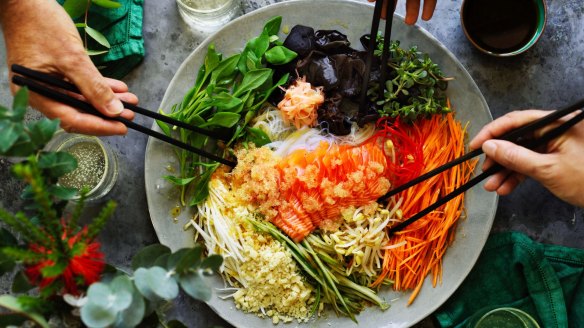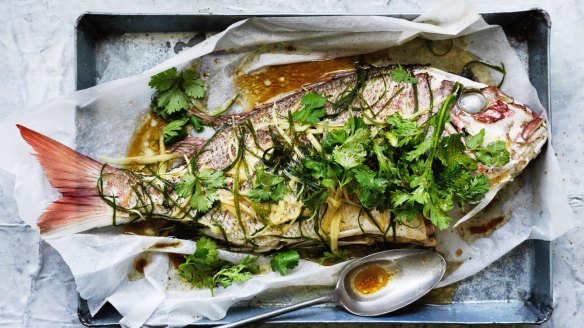A guide to the auspicious meanings behind Chinese New Year foods

- Lucky 88 recipes for Chinese New Year
- How to make Kylie Kwong's Lunar New Year feast
- Spanner crab and ginger dumplings with Sichuan chilli oil recipe
Lunar New Year is a time to reunite with family, exchange red envelopes, and, of course, eat a ridiculous amount of food. For many Chinese migrants, food plays a special role in celebrations, providing a link to cultural traditions and customs.
"My family are very Westernised," says Angie Chong of The Humble Dumpling. "The food is probably the one thing that holds us together, keeps us bonded through food and to our traditions."
Many common dishes for the occasion are passed down through the generations and contain auspicious meanings.
The extent to which these auspicious meanings are heeded can vary. For Hong Kong Food City author and chef Tony Tan the superstitions are secondary to tradition. "I don't actually believe in [them] as a superstition but I believe in maintaining tradition," he says. "I believe that for us Chinese people it's really important to maintain our tradition even if we are living in a different culture."
Lee Ho Fook chef Victor Liong feels similarly. He prepares celebratory dishes with flavour profiles he enjoys, and if they happen to have lucky connotations, all the better.
"It's mostly just delicious food that's easily enjoyed by everyone, with a familiar flavour memory towards tradition, family and celebration," Liong says.
Here are some dishes that will grace the chefs' Lunar New Year dinner table, and the auspicious meanings behind the ingredients.

Whole fish
You can't have a Chinese New Year feast without a whole fish, which is considered propitious because the Chinese word for "fish" sounds like the word for "surplus".
"I'll do a whole fish...and just steam it," Liong says. "We've always done a whole fish because of its auspicious connotations."
It's usually steamed with a mixture of spring onions, ginger, garlic and soy sauce – if there was ever a flavour combination to define Chinese cooking, this might be it.
Liong will probably use a Murray cod this year. "I like a gelatinous white fish that's not too big," he says.
A whole fish is vital, Tan stresses. "It has to have a head and tail simply because there is the beginning and end of a story."
Dumplings
The humble dumpling, mainstay of Chinese cuisine worldwide, also has a symbolic Lunar New Year meaning: wealth.
The symbolism comes from their shape, which can resemble money bags or the boat-shaped ingots used as currency in ancient China.
Chong will be folding her dumplings to resemble money bags with a 360-degree pleat.
"It's pleated all the way around and then you bring it up and pinch it at the top, and it looks like a money bag or purse, symbolic of wealth and abundance."
She fills her dumplings with water chestnuts, spring onion, minced pork and prawns.
Liong's family will be preparing three flavours of dumplings: "Pork and garlic chives, pork and cabbage, pork and coriander – that's the Liong household trio."
Eating dumplings was originally a northern China tradition, Tan notes, but has spread across China. "There are a lot of people who do eat dumplings simply because the Chinese are very superstitious. So anything that indicates good luck, good fortune, good health, good whatever else, you just eat!"
Whole chicken
In China, eating a whole chicken was considered a luxury, reserved only for the most special of occasions, says Chong. With whole chooks available in every supermarket, the dish may have lost some of its excitement, but is still a must for ringing in the new year.
"If you have a chicken it's like the phoenix, so it has to have a head and a tail," Tan says.
Chong's chicken dish has special significance as the recipe was passed down from her grandmother. "It's our favourite chicken dish – it's a way of linking us to our ancestors."
Chong will glaze the chicken with a mixture of maltose, vinegar and soy, and stuff it with salt, sugar, ginger, garlic, spring onion, soy sauce and Chinese wine, before roasting it.
Liong will be making drunken chicken, made by steeping the bird in alcohol. It's served cold, to offset the summer heat.
Nian gao
Otherwise known as sticky rice cakes, these divisive snacks are auspicious as "nian" can mean both "stick"' and "year", while "gao" has the same sound as "tall". Saying "nian nian gao gao" to someone means you're wishing that all aspects of their life will rise year on year.
"Some people love [nian gao] and some people hate it," Tan says.
Liong isn't a fan. "I think we'll have one on the table and no one will touch it," he says. "It's like Christmas pudding – you have to have one but no one likes it."
Nian gao varies from region to region. In the south of China it tends to be sweet and brown, formed into hand-sized squat cylinders. Nian gao from the north are white and can be savoury and cooked in a stir-fry, or sweetened with white sugar.
The former is the style Tan is familiar with. Wobbling satisfyingly to the touch, these nian gao are soft, sweet and sticky like toffee.
"Because it is round it symbolises family unity," he says.
Dried oysters and black moss
Hailing from southern China, this dish means "good news" and "prosperous" in Cantonese. The black hair moss, so called for its long black strands, is called "fat choy", sounding similar to the common blessing "gong hei fat choy".
Dried oysters are soaked in water, then braised with black moss, says Tan. Other ingredients may be added to the dish, such as soy bean sticks, vermicelli noodles (for long life), and "anything that has symbolic meaning behind it".
Chong's family will be eating pig trotter with black moss. Pork is particularly important this year as it's the Year of the Pig, she says. "The pig is a great animal, it represents home and loyalty."
Yusheng (raw fish)
The messiest dish on this list, yusheng – literally "raw fish" – is made by tossing raw fish with other ingredients such as vegetables, crisp wonton pastry, peanuts and a sauce.
Tan says the salad was popularised in Malaysia and Singapore before creeping up into southern China.
It represents prosperity, with a big part of its meaning coming from what happens at the dinner table. Everyone uses chopsticks to toss the fish and ingredients together high in the air, while chanting lucky rhymes such as "nian nian you yu" - meaning to be prosperous year on year. The higher you toss the salad, the better your New Year luck.
Chong's version of yusheng includes pomelo, cucumbers, red and purple carrots, lettuce and an apricot sauce.
Peanuts and sunflower seeds
Peanuts and sunflower seeds are the Chinese equivalent of popcorn. Commonly bought with the shells on, they're the snacks of choice to sit down with while watching the annual Chinese New Year Gala, live-streamed from China from midnight to 3am. The unshelling gives fidgety hands something to do and the end of the night invariably sees a small mountain of shells piled on a scrapof newspaper.
Sunflower seeds and peanuts have auspicious meanings for some, with the Chinese character for "seed" representing a blessing of having many children. For others, it's just something they've grown up with as a snack.
From our partners
Original URL: https://www.theage.com.au/goodfood/a-guide-to-the-auspicious-meanings-behind-chinese-new-year-foods-20190204-h1atsc.html